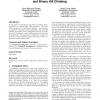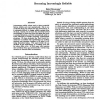1410 search results - page 162 / 282 » Mobile Robots and Intelligent Environments |
ATAL
2010
Springer
13 years 10 months ago
2010
Springer
A central problem in artificial intelligence is to choose actions to maximize reward in a partially observable, uncertain environment. To do so, we must learn an accurate model of ...
GECCO
2006
Springer
14 years 26 days ago
2006
Springer
In this paper an evolutionary algorithm is used for evolving gaits in a walking biped robot controller. The focus is fast learning in a real-time environment. An incremental appro...
AAAI
1998
13 years 10 months ago
1998
This paper presents a motivational system for an autonomous robot which is designed to regulate human-robot interaction. The mode of social interaction is that of a caretaker-infa...
CEC
2010
IEEE
13 years 10 months ago
2010
IEEE
Evolving a robot's sensor morphology along with its control program has the potential to significantly improve its effectiveness in completing the assigned task, plus accommod...
AIPS
1994
13 years 10 months ago
1994
Autonomousmobile robots need to detect potential failures reliably and react appropriately. Dueto uncertainties about the robots and their environment,it is extremelydifficult to ...


